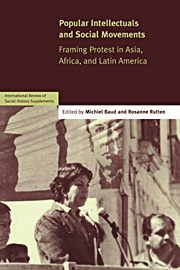Book contents
- Frontmatter
- Contents
- List of Contributors
- Introduction
- Framing, Transnational Diffusion, and African-American Intellectuals in the Land of Gandhi
- Indigenous Communists and Urban Intellectuals in Cayambe, Ecuador (1926–1944)
- Reforming Mysticism: Sindhi Separatist Intellectuals in Pakistan
- Unemployed Intellectuals in the Sahara: The Teshumara Nationalist Movement and the Revolutions in Tuareg Society
- Between Sovereignty and Culture: Who is an Indigenous Intellectual in Colombia?
- Critics and Experts, Activists and Academics: Intellectuals in the Fight for Social and Ecological Justice in the Narmada Valley, India
- Framing Jihad: Intramovement Framing Contests and al-Qaeda's Struggle for Sacred Authority
- Popular Publics: Street Protest and Plaza Preachers in Caracas
- Concluding Remarks: Framing Protest in Asia, Africa, and Latin America
Critics and Experts, Activists and Academics: Intellectuals in the Fight for Social and Ecological Justice in the Narmada Valley, India
Published online by Cambridge University Press: 04 August 2010
- Frontmatter
- Contents
- List of Contributors
- Introduction
- Framing, Transnational Diffusion, and African-American Intellectuals in the Land of Gandhi
- Indigenous Communists and Urban Intellectuals in Cayambe, Ecuador (1926–1944)
- Reforming Mysticism: Sindhi Separatist Intellectuals in Pakistan
- Unemployed Intellectuals in the Sahara: The Teshumara Nationalist Movement and the Revolutions in Tuareg Society
- Between Sovereignty and Culture: Who is an Indigenous Intellectual in Colombia?
- Critics and Experts, Activists and Academics: Intellectuals in the Fight for Social and Ecological Justice in the Narmada Valley, India
- Framing Jihad: Intramovement Framing Contests and al-Qaeda's Struggle for Sacred Authority
- Popular Publics: Street Protest and Plaza Preachers in Caracas
- Concluding Remarks: Framing Protest in Asia, Africa, and Latin America
Summary
Summary: The following article examines the role of popular intellectuals in the rise of the Narmada Bachao Andolan, a mass-based movement opposed to the building of large dams in the Narmada Valley of central India. In particular, it focuses on two of this struggle's most prominent public figures and spokespersons, Medha Patkar and Arundhati Roy. The article examines the relationship between these individuals and the movement itself – how issues have been framed by Patkar and Roy for local, national, and international audiences, how support for the antidam struggle has been mobilized, and how each of these figures are themselves perceived and portrayed. The article will also examine some of the challenges faced by the movement and its leaders, not only from proponents of the dam projects, but also from other social activists and intellectuals. The latter have raised questions about representation, voice and strategy, as well as insider/outsider authenticity and legitimacy in the anti-dam movement, issues that this paper considers in some detail. Finally, the article draws on the Narmada case to ask some broader questions regarding popular intellectuals and social movement organizing and strategy.
INTRODUCTION
This paper examines the role of popular intellectuals in the rise of a massbased social and ecological justice movement mobilized against the building of large dams in the Narmada Valley of central India through the latter half of the twentieth century. This movement has enjoyed widespread support both nationally and internationally and has drawn upon a vibrant and longstanding local tradition of opposition to hydroelectric dam projects in order to raise questions about the nature and purpose of economic and social development in the region.
- Type
- Chapter
- Information
- Popular Intellectuals and Social MovementsFraming Protest in Asia, Africa, and Latin America, pp. 133 - 158Publisher: Cambridge University PressPrint publication year: 2005
- 1
- Cited by

